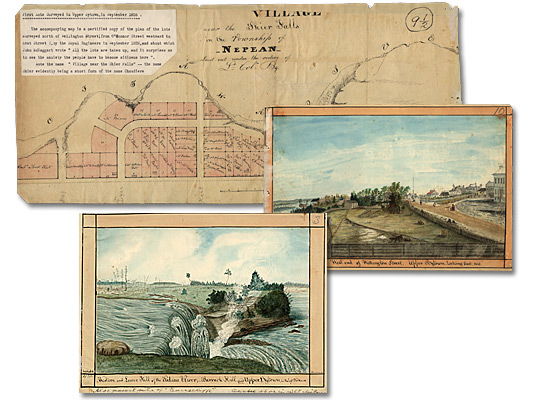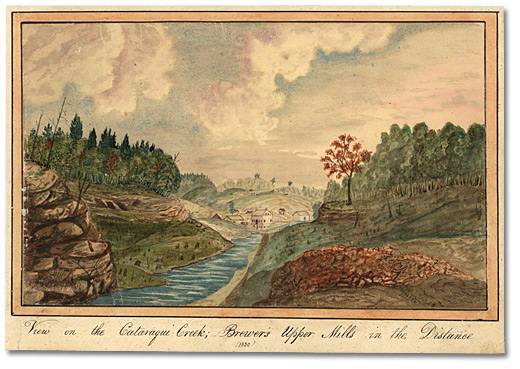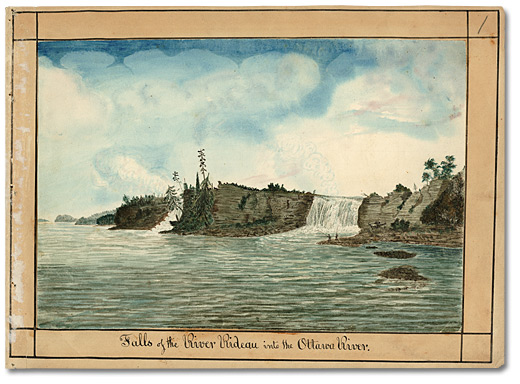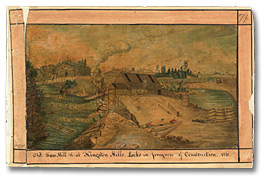
Into the Public Domain
The Thomas Burrowes collection at the Archives of Ontario includes 115 watercolours bound together in albums. Some of these works show scenes from the St. Lawrence River and Lake Ontario. Most relate to the Rideau Canal.
In his paintings, Burrowes sketches the landscape as it was during the building of the canal and positions within it buildings and equipment (winches and lock mechanisms), men at work (excavating soil with shovels and wheelbarrows) and boats (large, eight-man transport canoes, smaller skills, rowboats and rafts of logs and, after completion of the waterway, steamboats with the barges attached behind them). He occasionally provided a sequence of views at a particular site, showing different stages of construction.

The paintings were discovered in 1907 in the attic of one of Burrowes’s daughters who was living in Detroit, Michigan at the time. They were donated to the Archives of Ontario in 1948 by Burrowes’s grandson, A. H. D. Ross, the author of an early history of Ottawa.
A Private, Precious Gift

Click to see a larger image (334K)
View on the Cataraqui Creek, Brewer's Upper Mills in the background, 1830
Watercolour
Thomas Burrowes fonds
Reference Code: C 1-0-0-0-64
Archives of Ontario, I0002183
Ontario history buffs can generally recognize the work of Thomas Burrowes at a glance. A collection of 115 watercolours by Thomas Burrowes passed from private to public hands nearly 60 years ago, one of the most important ever private donations to the Archives of Ontario. Since then, these paintings have become some of the most famous images in Ontario history, and they are in constant heavy demand among writers and researchers. It is the Archives’ responsibility to balance preservation of these precious documents with accessibility to the public. The development of conservation science and electronic communications technology makes that balancing act much easier today.

Click to see a larger image (326K)
Falls of the Rideau River, at the Ottawa River, 1826
Watercolour
Thomas Burrowes fonds
Reference Code: C 1-0-0-0-01
Archives of Ontario, I0002118
Discovery and Donationt
After the death of Thomas Burrowes in 1866, his watercolours went into hiding for many years in the attic of one of his daughters in Detroit, Michigan. In time, however, they were presented to a grandson, A.H.D. Ross, who in 1927 described the gift:
“Twenty years ago some of the original field-notes, maps, plans and copies of official correspondence relating to the construction of the Rideau Canal and the founding of Bytown were presented to the author by an aunt living in Detroit, Michigan…. [including] 115 accurately drawn and artistically finished water-colour paintings done by Thomas Burrowes….”
In 1948, A.H.D. Ross presented this treasure trove to the Archives of Ontario.
Conservation
The gradual darkening of varnish over time has obscured some details in this work.

Click to see a larger image (86K)
Locks under construction, at the Saw Mill at
Kingston Mills, 1830
Watercolour
Thomas Burrowes fonds
Reference Code: C 1-0-0-0-71
Archives of Ontario, I0002190
Caring for the collection
There were no conservators on staff in 1948, when A.H.D. Ross donated these paintings to the Archives of Ontario, and there is thus no record of how the collection was stored or treated in those early years. Today, however, the job of highly trained conservators is to assess condition, plan remediation if possible, and recommend storage methods that will keep the documents in safe and stable condition. In the case of the Burrowes paintings, each work is kept in an individual folder with a tissue sleeve and stored with 20 to 30 other paintings in a protective box in conditions of controlled temperature and humidity.
A recent review found that most of the paintings are in fair to good condition, with only minor tears and abrasions. The most serious damage, in the form of steadily darkening varnish, affects only a few images. Sadly, the damage is impossible to repair, given the fragile nature of paper and the solubility of watercolours.
Assessment
Filing a full report
As a result of a recent comprehensive survey, important information has now been collected on every Burrowes painting. The record includes the physical dimensions of each painting, along with notations on media (paint and ink), the existence of copy negatives and details of current housing. Finally, and most importantly, the documents are rated for condition and, if necessary, treatment is recommended. The review concluded that the paintings were mostly in “fair” condition, with only a few rated “poor” (with tears, stains, varnish or remnants of paper from the album still adhering to the back). No emergency treatment was deemed necessary.
Observation
Important clues
Many of the conservator’s observations are technical – size, medium, condition, etc. However, careful assessment of a document sometimes yields other valuable information. Conservators note, for example, that the Burrowes paintings were originally bound into two albums. The album covers have been preserved, and some paintings have linen tape along one edge, possibly part of the old binding. Also, at some time long ago, most of the paintings were pasted on to thick paper backings and framed with black ink borders and titles carefully written on in a typical 19th-century hand. There are also pin holes in some of the images. These holes were made before the paintings were mounted and labeled: this suggests that once upon a time the paintings were casually pinned up, as though for reference. Did Burrowes use these paintings as visual references when writing his Rideau Canal inspection reports? We can only guess. A couple of the works have been varnished, on the other hand, as though to enhance their brightness for display.
Public Access

More and more available
Whereas maintaining the good physical condition of the collection is the work of the conservator, its use is governed by archivists. It is their job to describe the records and index them in a way that makes them available to the widest possible constituency.
The success of the Archives of Ontario in making the paintings available to the public over the years is demonstrated by the popularity of the images by historians. This is a very heavily used collection, and the paintings are familiar to everyone who is interested in Ontario history or the Rideau Canal.
Technology
The effect of technology is to broaden the marketplace. All of the paintings have been digitized, and today they are available online, so that anyone wishing to see the paintings need only visit the Archives’ website. The fact that such documents can be made available electronically is more than convenient for researchers in Ontario and Canada and the world. Digitization is also a means of preserving the original documents from overuse and gradual degradation.